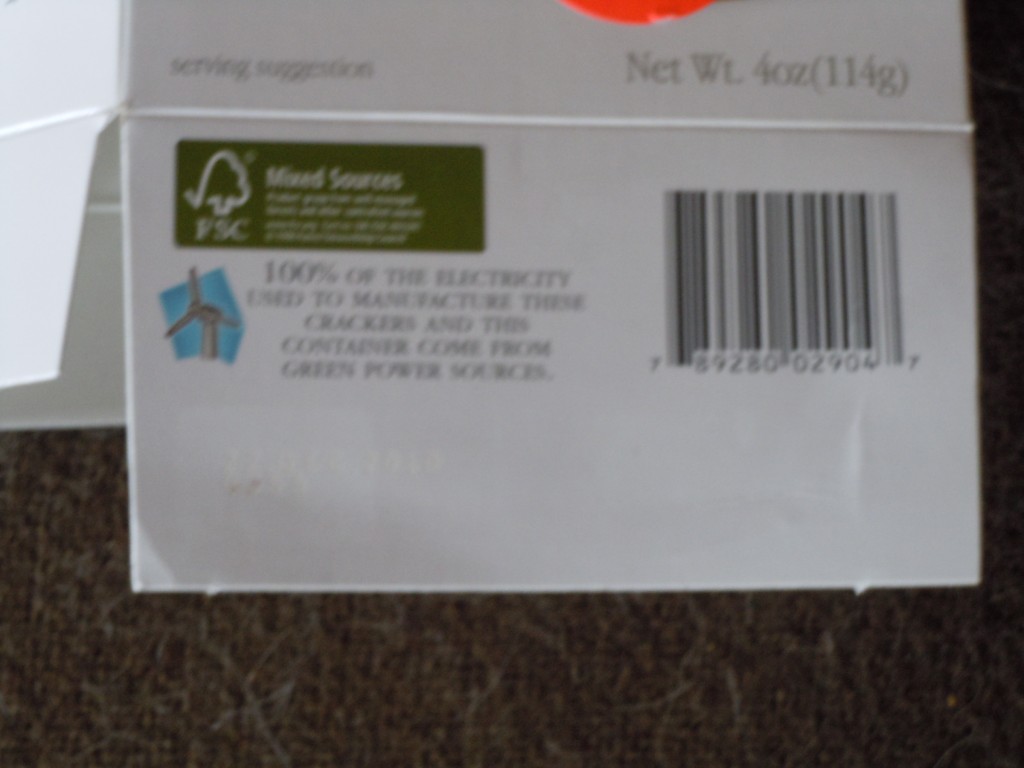If You’ve Gone Green—Don’t Hide Your Light!
By Shel Horowitz
The box says “100% of the electricity used to manufacture these crackers and this container come from green power sources,” and has a nice little accompanying graphic of a windmill. Just above this is a Forest Stewardship Council certification logo denoting sustainably harvested timber sources for the box.
This is a company that’s doing the right thing, right?
Wrong. Both of these logos and statements are on the bottom panel of the box, where no one can see it unless they’ve already bought the crackers—or perhaps if the prospect accidentally knocks the package off the supermarket shelf, happens to land the bottom facing up, and somehow notices the small logos while picking up the box.

In other words, the marketing benefit of their commitment is just slightly above zero.
This particular package has plenty of white space on the front panel, prime real estate that does have a heksher (Kosher certification logo) but otherwise, does very little marketing at all.
This cracker company (which I will not name publicly) is far from alone.
Another example, which I highlight as a case study in my talks, is the household paper products company, Marcal. When I ask my audiences what year they think Marcal switched to recycled paper, most of the answers tend to fall between 1985 and 2005. Occasionally someone will guess a year in the 1970s, especially if I call the company a pioneer in using recycled stock.
Not once has anyone guessed the correct answer—1950—or even (with one exception) the correct decade. Because, for too long, like the cracker company, Marcal kept its best marketing point hidden. Even though the company has been 100% recycled for more than 60 years, it was only in the past decade that it started incorporating this vital message into its packaging–and only since 2009 that environmental branding has become the central focus of its message to consumers.
You just have to wonder how much more toilet paper, napkins, tissues and paper towels the company would have sold if it had started bragging earlier. I know that when I first became aware of environmental concerns in the early 1970s, I would have been thrilled to find a cost-competitive brand that was also very green.
Like Marcal, the Swiss cereal company Familia has been using sustainable practices—in this case, buying grains from sustainable farms—for decades. But it was only early in 2010 that I noticed this was finally explained on its packaging.
These are three examples among hundreds.
Why do companies take the time and trouble to do good in the world, and then act like they’re embarrassed about it? Perhaps it’s a matter of corporate humility, not wanting to brag. In some cases, maybe it’s worry about being accused of greenwashing–an accusation that could definitely hurt.
In Marcal’s case, it may have started as a legitimate fear that people wouldn’t buy household paper made of other people’s castoffs, even if it was just their sterilized junkmail. In the conformist, status-conscious 1950s, it may not have been seen as a marketing strength, but as a liability.
But certainly by 1980 if not well before, what we now call Cultural Creatives were a well-established and rapidly growing marketing demographic. As far back as the 2000 publication of their book, The Cultural Creatives: How 50 Million People Are Changing the World, Paul H. Ray and Sherry Ruth Anderson estimated that more than a quarter of all adults in the developed countries they studied fell into this category. A quarter of the population!
Greenwashing accusations are easily defused with one simple rule: tell the truth. As for corporate humility, it’s not doing those companies any favors. I see both a bottom-line advantage and a save-the-world benefit to trumpeting an honest green message. On the financial side, you’re able to market much more effectively to that vast market segment.
But even more to the point, you help make the world a better place. Every company that shares its green initiatives publicly shows consumers that there are sustainable alternatives, pressures competitors to also go green, and continues to generate momentum toward a better world.
Shel Horowitz, shel at greenandprofitable.com, shows you how to “reach green, socially conscious consumers with marketing that has THEM calling YOU.” He writes the Green And Profitable/Green and Practical columns and is the primary author of the award-winning and environmental category best-selling Guerrilla Marketing Goes Green (John Wiley & Sons, 2010).

Leave a Reply